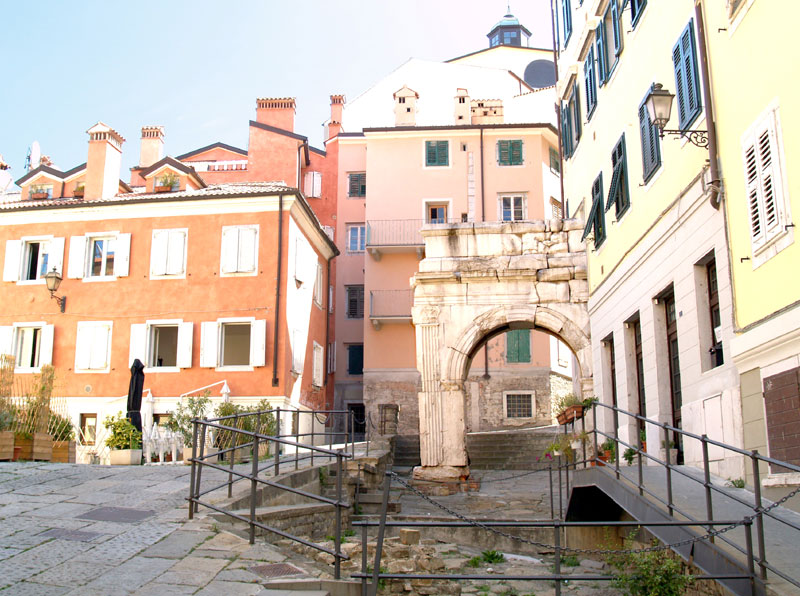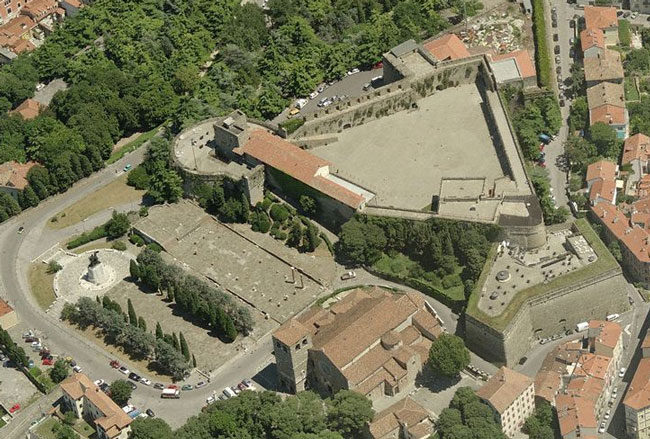Red Itinerary
Red itinerary start in Piazza Unità d’Italia
Stage 1. – Museo d’Arte Orientale
Palazzetto Leo
via San Sebastiano 1
www.museoarteorientaletrieste.it
The Civico Museo d’Arte Orientale is situated in the heart of Trieste, just a stone’s throw from Piazza dell’Unità d’Italia.
Exhibits are arranged on four levels and include Oriental artworks, arms, musical instruments and ethnographic objects, mainly from China and Japan. On the ground-floor, acting as an introduction, one can see how commercial relations were established between Trieste and the East, starting in the 1700s and developing in the 1800s, when the ships of the Austrian Lloyd Shipping Company left Trieste and passed along the Suez Canal, finally reaching the far-away coasts of India, China and Japan. A special space is dedicated to an interesting group of sculptures from the Gandhara, dating from between the 1st and 4th centuries AD, which were collected during the Italian expedition to the summit of K2 in 1954.
The 1st floor is dedicated to Chinese art, including embroidered silk dresses and textiles from the late Qing Dynasty (19th century); china dating from the Song Dynasty (11th-13th centuries) to the late Qing Dynasty (19th century); sculptures and objects connected to Confucianism, Taoism and Buddhism — China’s religions.
On the two upper floors, the Museum displays its Japanese section, starting with porcelain, and culminating in the hall which houses the Ukiyo-e – i.e. the Images from the Floating World – print collection, with works by great Japanese masters such as Hiroshige and Hokusai, with his famous Wave.
It is possible to get a glimpse of traditional kabuki theatre, to get closer to the rites and traditions of Shinto and Buddhism and finally, through the rich collection of arms and armoury from the 15th to the 19th centuries, to explore a Samurai’s life and moral code.
>> Continue to the next stage
Stage 2. – Oil Press
Via dei Capitelli, 8
An olive press constructed in the 5 th century, using a decorated parallelepiped block from a burial monument of the 1st century A.D., is located in the building at via dei Capitelli 8. The same area also contains a section of road built around the same time as a gate in the late Roman wall,recognizable nearby, at the intersection with via Crosada.
>> Continue to the next stage
Stage 3. – Arch of Riccardo
Piazza Barbacan

The Roman gate shows signs of reconstruction,around the middle of the 1 st century A.D.It was a passage through the city walls built by Augustus in 33-32 B.C., after they had lost their defensive function.
The gate is a simple,solid construction decorated with pilasters and a vegetable motif under the arch. Tradition links its name to the legendary passage through the city of King Charlemagne or of Richard the Lion-hearted. It could also derive, however, from the word “cardus” (the Latin name for one of the two main thoroughfares in Roman cities ñ the other is the decumanus) or could be a corruption of the term ìricario î, the medieval magistrature that probably held court in this district.
>> Continue to the next stage
Stage 4. – Sanctuary of Saint Mary Major
Piazza S. Silvestro
The Sanctuary of St. Mary Major was built (1627 – 1682) by the Jesuits, that had arrived in the city in the first years of the century. The work however was completed after a long time. The church has a Latin cross plan; the three-aisle hall has a barrel ceiling, while at the junction of the transept rises the dome. In the apse the great fresco of the Immaculate Conception shines out, made in 1842 by Sebastiano Santi. On the main altar, built between 1672 and 1717, there are the statues of Jesuit Saints Ignatius of Loyola, Luigi Gonzaga, Francesco Borgia and Francesco Saverio, accompanied by Angels. On the right of the presbytery the chapel of Our Lady of Health opens, with the image of Mary perhaps painted by Sassoferrato. Left of the presbytery there is the chapel of the Crucifix. In the wings of the transept the 17th century altars dedicated to Saints Ignatius and Francesco Saverio face each other. In the aisles three more altars are placed. In the panaches of the dome Giovanni Battista Bison painted the four Evangelists in the first years of the 19th century.
Basilica di San Silvestro
The Romanesque basilica of St. Silvestro is the oldest church of the city (11th or 12th century). On the faÁade stands out a sober and elegant rose window, while, in front of what was the main door, we can admire the Romanesque porch surmounted by the steeple that was decorated, with some elegant mullioned windows. A memorial plaque of 1672 reminds us that this was the primum templum et Cathedrale of the city. Above the main door a plaque in Latin narrates that in 1785 (Joseph II), the Church was auctioned off at the cost of 1500 florins and was bought by some members of the Evangelical Community of Helvetian denomination, who, after a sober restoration, reopened it to the Protestant cult, dedicating it to Christ the Savior. In 1928 the basilica was listed among the national monuments. Since the end of the 19th century the Helvetian community was accompanied by a Waldesian community, Protestant as well.
>> Continue to the next stage
Stage 5. – Museo Civico di Storia e Arte
Piazza della Cattedrale, 1
www.museostoriaeartetrieste.it
The 18th century museum features a collection of tombstones and the finding of local history dating from prehistory up to around the th century A.D.The collection formed around the monument of J.J.Winckelmann, considered the father of archeology, who was murdered in Trieste in 1768. The museum also contains collections from Egypt, Cyprus, Greece and the colonies of Magna Graecia,
from Etruria and even a small collection of Mayan ceramics from El Salvador.
>> Continue to the next stage
Stage 6. – San Giusto Cathedral
(11th – 14th century)
Piazza della Cattedrale, 3

In the 5th century, a church with three Naves was erected utilising a pre-existing Sacred Roman edifice. In the middle of the 11th century, a Romanic basilica dedicated to the Virgin was built upon this structure. About the same time, the San Giusto votive Chapel (sacellum), a small basilica for the worship of sacred relics, was constructed to the right of it. Portions of the wall and two of the three apsides of the original structure still remain.
Although the three-lighted window on the right side of the cathedral and the tambour of the cupola date from the restoration of the 1920ís, they are based upon original elements. The slope-roofed facade of the cathedral, dominated by a large rosette, was built in the 14th century following the unification of the pre-existing structures in a building with five naves. The door-jambs of the main entrance come from a sepulchral monument of the 1st century AD, belonging to the Barbi family. Interior: frescoes,13-14th century; painted panels and sacred goldwork, 14th century; sarcophagi of the Triestine martyrs,11th century. Inside: frescoes, 13th century; sarcophagi of Triestine martyrs,11th century.
>> Continue to the next stage
Stage 7. – San Giusto Hill
Piazza della Cattedrale

Propylaeum and Roman Basilica
The main monumental buildings of Roman Trieste were built on the summit of San Giusto hill.In the second half of the 1 st century A.D.,the so-called Propylaeum was built,with the civil Basilica in the original plan. The Propylaeum served as the monumental entrance to a sacred, enclosed area believed to have held the Capitoline temple.It consisted of two large lateral colonnaded structures with a stairway at the center.
The vastness of the visible remains gives a good idea of the magnificence of the work. They are now partly incorporated in the bell tower of the cathedral,while the portion buried in the area in front,the stairway and the structure on the right are visible,proceeding downward into a tunnel that opens on the Stone Garden. The archeological digs carried out between 1929 and 1934 brought to light the remains of the civil Basilica,to the left of the Propylaeum. The structure consisted of three naves.
Castle of San Giusto
www.castellodisangiustotrieste.it
Inside the Castle of San Giusto, the 16th-century Bastione Lalio houses the ‘Lapidario Tergestino’. This collection includes more than 130 items, mainly inscriptions and sculptures, which illustrate the history of Roman ‘Tergeste’: its monuments from the Capitoline hill, the sacred buildings, the Theatre and the necropoles.
The first room houses some of the better-known monuments, including the inscriptions which were affixed near the city gates to celebrate the building of the city walls and towers, whose construction had been commissioned by Octavian in 33-32 BC; and the base of the equestrian monument dedicated by the plebs tergestinorum to Lucius Fabius Severus, an eminent local citizen who became a Roman senator and thus managed to pass some laws that were beneficial for his native city. Additional items comprise an architrave dedicated to admiral Clodius Quirinalis, the base of an equestrian monument to Valerius Festus and two pyramidal altar tops bearing the symbols of Jupiter, Minerva and Juno.
The second room displays imperial inscriptions honouring the interventions of emperors Adrian, Antoninus Pius and Marcus Aurelius in the construction of public buildings in the city. The room also houses material from the ancient Roman Basilica, whose monumental archaeological remains can still be seen today in the square at the foot of the castle.
The large upper room houses sepulchral monuments. These are divided according to their place of origin and comprise altars, steles, cippi, urns and sarcophagi bearing the names of ancient local citizens. The room also includes a sector devoted to places of worship and deities, with dedications to Jupiter, Cybele, Silvanus, Bona Dea, Hercules and Minerva. The exhibition continues with material found during the excavation of the Roman Theatre. This consists of an exceptional series of statues, which used to decorate its scene. They include Venus, Bacchus, Apollo, Minerva, Hygieia and Aesculapius.
The Lapidario Tergestino’s last room is dedicated to the mosaics which were found in a lavish seaside villa in Barcola, on the outskirts of the city. These mosaics can be dated to between the end of the 1st century BC and the middle of the 1st century AD; they are characterised by the elegant taste of their rich owners and their attempt to imitate the villas of Augustus, Tiberius and Nero.
A fragmented marble statue of an athlete stands in the middle of the room. This is a copy from the time of Nero of the original bronze statue created by eminent Greek sculptor Polyclitus in the 5th century BC, and was also found in the villa. This statue itself shows how richly decorated the building must have been.
>> Continue to the next stage
Stage 8. Tor Cucherna
(XIV sec.)
Torre “Cucherna”
The polygonal tower, open on the inner face, formed part of the Castleís eastern defences. Some sources indicate it with the name “Chiauchiara”. The crenellated upper portion of the tower is the result of 20th century restoration.
>> Continue to the next stage
Stage 9. – Roman Amphitheatre
Built at the second half of the first century, on the seashore, at the inferior extremity of the hill of Saint Giusto, the theatre capable of holding 6000 spectators. The highest part of the stairs and the stage were made of wood. Very little is left: only the basement of the fixed part of the scene and the bases in masonry of the pillars of the porch. As for other roman monuments, it subjected to the divestment of the precious stones and already ready for other uses. Thus it became the solid ground of the houses built above. Pietro Nobile, individuated it in 1814, guided also by the name of the place Ancient Arena, but it was only in 1938 that it was discovered after the big works of demolition and re-urbanization in 1938.
>> Continue to the next stage
10. – Ghetto
The ancient ghetto extends very close to the Borsa palace and the main square of Trieste, piazza Unit‡, showing through this position the central role reached by the Jewish Community of Trieste, already in 1696, when the ghetto was established.
In fact, it was established by Leopold I of Habsburg with an imperial decree, on the 28th November 1696, the ghetto is placed in Riborgo, into the commercial heart of Trieste. The Jews, about a hundred, enter the ghetto in 1697. Created with the requisition of many houses, the entrance is placed in the Portizza di Riborgo. It is surrounded by a high wall and has three doors ñ in piazza del Rosario, at the end of via delle Beccherie and in Riborgo ñ looked out by Christian guards and closed from sunset to dawn. The quarter, set between piazza della Borsa and the Roman Theatre, is delimited by contrada Malcanton, contrada Ribordo and contrada delle Beccherie. The doors of the ghetto open in 1784, with the Tolerance Edicts of the emperor Joseph II and one year later the segregation was definitely abolished. The most part of the Jews keeps nevertheless living in this area.
The ghetto quarter and the synagogues are overwhelmed by the reorganization of the old town decided by the fascist regime. The ritual object that used to frame these ancient placet of cult can now be admired inside the Jewish Museum Carlo and Vera Wagner, in via del Monte 7. Today the persistent traces of the Jewish presence in Trieste can be seen in the Riborgo ghetto, delimited by piazza Unit‡ díItalia, piazza della Borsa, the Roman Theatre, via Torbandena and via Malcanton. The ways of the quarter, in which the main axis is via delle Beccherie, are still full of shops and jobs typically linked with antiques, furniture and books sale and restoration and they keep the vitality and the happiness which have characterized them for centuries.
